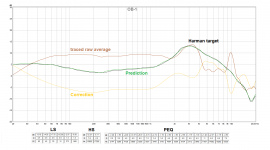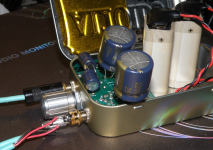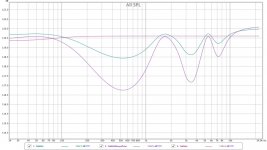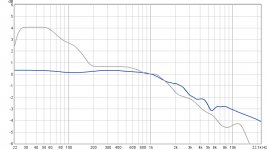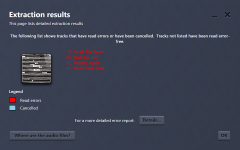Thanks BYRTT, I arriver at the best buffer settings with loop back tests that included the DAC. Perhaps it will work here as well to find a sweet spot.
For now I'll continue in JR22 as I still have a few things I like to try.
Re-doing all of the settings and corrections made me think back of all the different sounds I have experienced trough these years of experiments. Still busy to get the best of all of that combined into one. Basically still learning and figuring out what does what to/for my perception.
In time I'll revisit the 64 bit path again, it won't walk away.
For now I'll continue in JR22 as I still have a few things I like to try.
Re-doing all of the settings and corrections made me think back of all the different sounds I have experienced trough these years of experiments. Still busy to get the best of all of that combined into one. Basically still learning and figuring out what does what to/for my perception.
In time I'll revisit the 64 bit path again, it won't walk away.
Understandable especially because you right in it sounds bit different and that can be a problem for computer with serious many and complicated corrections/tricks, thats reason i didn't touch my many hundreds of corrections Jriver computer that steer speaker and think will wait some time and let 64bit version mature a bit.
But must say it performs awesome here on simple player computer, after last post discovered if changed setting for JRiver ASIO buffer to double as before and sound cards ASIO buffer to half as before saved my light touch sweet pleasing air sound and bagground blacks doubled up or more 😀.
Then shifted to head phones and can't stop listening, well nearly sometimes sits here crying because it sound so crazy and real into these corrected head phones domain, especially after got new ripping tool for tracks and now these double up on bagground blacks.
Had a new pair of headphones this summer recommended by xrk971 because of high value and low cost, it was these STATUS AUDIO OB-1 (Link: Status Audio OB-1 Open Back Studio Monitor Headphones: Amazon.co.uk: Musical Instruments). After received those headphones didn't like their sound as much as xrk971 did but taste is taste and it was no problem in they low cost, but things did change quite much after xrk971 linked to a pro review site for headphones where they share pro measurement for raw data at five headphone positions for these OB-1 model, then i draw my own pencil in middle of those five curves to have average curve to correct, and HARMAN target curve for headphones was also to find at that site so rest was done in Rephase and curves can be seen below.
Also got one of xrk971's nice Tin can class a headphones amps, although it sounds great as designed have mod it a bit in input and output caps are no more multiply bypassed sets but single big values, and because i really like sound of solid core cable and have it all over system then headphones Litz cable is also shifted to solid core cable as seen below.
Should you wesayso be interested in review these corrected headphones performance and X's class a amp i be happy pay shipping to NL and return and get feedback if my findings is as sky-high as myself perceive.
But must say it performs awesome here on simple player computer, after last post discovered if changed setting for JRiver ASIO buffer to double as before and sound cards ASIO buffer to half as before saved my light touch sweet pleasing air sound and bagground blacks doubled up or more 😀.
Then shifted to head phones and can't stop listening, well nearly sometimes sits here crying because it sound so crazy and real into these corrected head phones domain, especially after got new ripping tool for tracks and now these double up on bagground blacks.
Had a new pair of headphones this summer recommended by xrk971 because of high value and low cost, it was these STATUS AUDIO OB-1 (Link: Status Audio OB-1 Open Back Studio Monitor Headphones: Amazon.co.uk: Musical Instruments). After received those headphones didn't like their sound as much as xrk971 did but taste is taste and it was no problem in they low cost, but things did change quite much after xrk971 linked to a pro review site for headphones where they share pro measurement for raw data at five headphone positions for these OB-1 model, then i draw my own pencil in middle of those five curves to have average curve to correct, and HARMAN target curve for headphones was also to find at that site so rest was done in Rephase and curves can be seen below.
Also got one of xrk971's nice Tin can class a headphones amps, although it sounds great as designed have mod it a bit in input and output caps are no more multiply bypassed sets but single big values, and because i really like sound of solid core cable and have it all over system then headphones Litz cable is also shifted to solid core cable as seen below.
Should you wesayso be interested in review these corrected headphones performance and X's class a amp i be happy pay shipping to NL and return and get feedback if my findings is as sky-high as myself perceive.
Attachments
How do you switch the EQ around?With Voxengo I just cross the left and right outputs after encoding and before decoding, in FabFilter I have to switch the EQ around.
Change everything from "m" to "s" and vice versa...
BYRTT, I'll comment in the morning... got to go 🙂
BYRTT, I'll comment in the morning... got to go 🙂
I did a test in Audacity on a mono Dirac Pulse in the Left Channel and Stereo Dirac Pulse, my preset here has a 0.5dB cut to the Mid Channel to avoid slight clipping.
The Mid signal doubles the peaks and dips in stereo as expected
The side signal has the bass rolloff with one channel but if stereo both are the same cancelling out to a flat line (not shown on the graph).
I decided to just disable the Mid or Side EQ rather than flip them 🙂
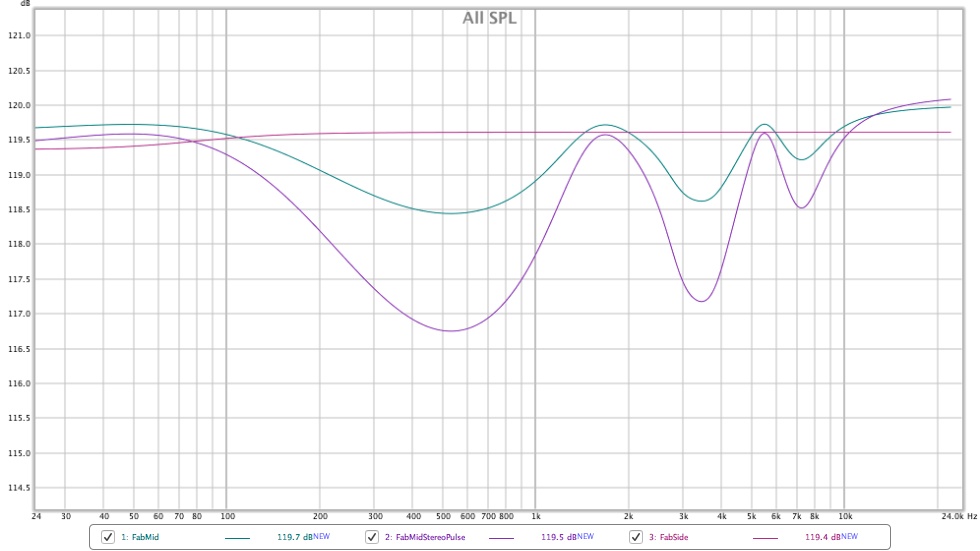
This looks like Byrtt's graph in an overall sense but the Q's are different, it is different to the comparison you showed before where there was a hump in the side channel and overall downward trend.
I'm interested because you prefer something different to what I have been using.
The Mid signal doubles the peaks and dips in stereo as expected
The side signal has the bass rolloff with one channel but if stereo both are the same cancelling out to a flat line (not shown on the graph).
I decided to just disable the Mid or Side EQ rather than flip them 🙂
This looks like Byrtt's graph in an overall sense but the Q's are different, it is different to the comparison you showed before where there was a hump in the side channel and overall downward trend.
I'm interested because you prefer something different to what I have been using.
Attachments
Hi fluid,
Have spied a bit 😛 and traced mid correction with downward trend and divided it with mine and result is blue below which has some in common to grey F.Toole trained listener curve, so can downward trend be some part of preferred tonal correction curve and this part actual needs linear phase correction so as to stay in phase with speaker+room performance, doing this part of downward slope in linear phase will slow phase timing expanding gradually from about 1kHz and then can guess on rest of tonal correction curve is set in other place as minimum phase correction.
Have spied a bit 😛 and traced mid correction with downward trend and divided it with mine and result is blue below which has some in common to grey F.Toole trained listener curve, so can downward trend be some part of preferred tonal correction curve and this part actual needs linear phase correction so as to stay in phase with speaker+room performance, doing this part of downward slope in linear phase will slow phase timing expanding gradually from about 1kHz and then can guess on rest of tonal correction curve is set in other place as minimum phase correction.
Attachments
Hi fluid,
Have spied a bit 😛 and traced mid correction with downward trend and divided it with mine
This is how wesayso described it
Another side note: the target used with this mid/side combo is not a flat or slowly declining target. It is a mixed target that does not follow a straight line at all. So don't be thrown off by the dip at high frequencies here.
I think it is harder to separate out as it was part of an overall correction where I just have it as a separate processing stage.
If these are as good as you say , they are crazily inexpensive...😀Understandable especially because you right in it sounds bit different and that can be a problem for computer with serious many and complicated corrections/tricks, thats reason i didn't touch my many hundreds of corrections Jriver computer that steer speaker and think will wait some time and let 64bit version mature a bit.
But must say it performs awesome here on simple player computer, after last post discovered if changed setting for JRiver ASIO buffer to double as before and sound cards ASIO buffer to half as before saved my light touch sweet pleasing air sound and bagground blacks doubled up or more 😀.
Then shifted to head phones and can't stop listening, well nearly sometimes sits here crying because it sound so crazy and real into these corrected head phones domain, especially after got new ripping tool for tracks and now these double up on bagground blacks.
Had a new pair of headphones this summer recommended by xrk971 because of high value and low cost, it was these STATUS AUDIO OB-1 (Link: Status Audio OB-1 Open Back Studio Monitor Headphones: Amazon.co.uk: Musical Instruments). After received those headphones didn't like their sound as much as xrk971 did but taste is taste and it was no problem in they low cost, but things did change quite much after xrk971 linked to a pro review site for headphones where they share pro measurement for raw data at five headphone positions for these OB-1 model, then i draw my own pencil in middle of those five curves to have average curve to correct, and HARMAN target curve for headphones was also to find at that site so rest was done in Rephase and curves can be seen below.
Also got one of xrk971's nice Tin can class a headphones amps, although it sounds great as designed have mod it a bit in input and output caps are no more multiply bypassed sets but single big values, and because i really like sound of solid core cable and have it all over system then headphones Litz cable is also shifted to solid core cable as seen below.
Should you wesayso be interested in review these corrected headphones performance and X's class a amp i be happy pay shipping to NL and return and get feedback if my findings is as sky-high as myself perceive.
I just ordered a pair, even though I have stated I do not care much for headphones, but @ this price as a mean to check tonal balance , I will give it a try.
What is this new ripping tool?
How do you do the corrections in Jriver? Is it just a graphic equalizer?
Should you wesayso be interested in review these corrected headphones performance and X's class a amp i be happy pay shipping to NL and return and get feedback if my findings is as sky-high as myself perceive.
I appreciate the offer, however I would not want anything happen to it on it's way. I think I'm going to look for German Maestro curves to correct 😉.
I'm intrigued by that headphone curve. Something I could want to try for myself. A pretty big drop up on the top end though...
I did a test in Audacity on a mono Dirac Pulse in the Left Channel and Stereo Dirac Pulse, my preset here has a 0.5dB cut to the Mid Channel to avoid slight clipping.
The Mid signal doubles the peaks and dips in stereo as expected
The side signal has the bass rolloff with one channel but if stereo both are the same cancelling out to a flat line (not shown on the graph).
I decided to just disable the Mid or Side EQ rather than flip them 🙂
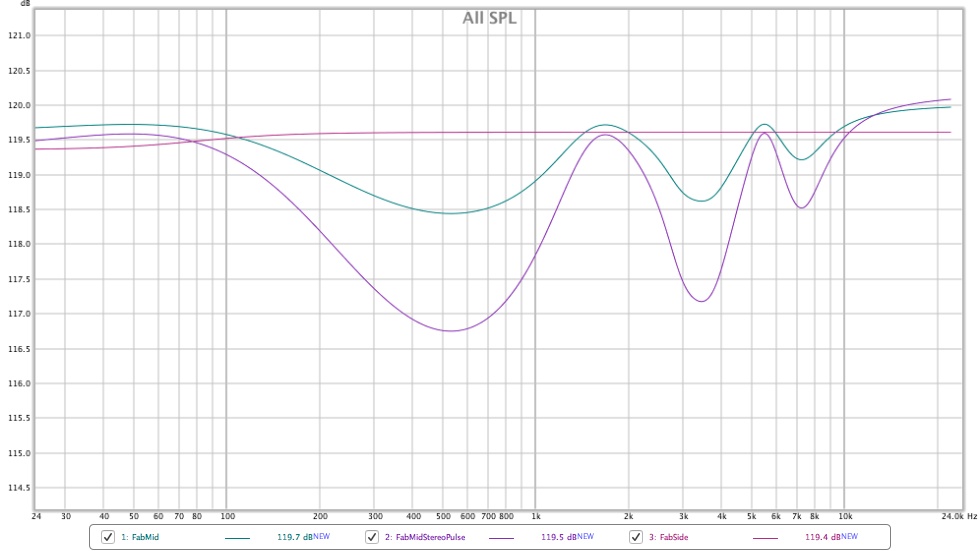
This looks like Byrtt's graph in an overall sense but the Q's are different, it is different to the comparison you showed before where there was a hump in the side channel and overall downward trend.
I'm interested because you prefer something different to what I have been using.
Mid/Side EQ is funny like that. If we filter the mid part we get L+R = 2x the same part. However the sides is only one channel minus the other one. So there is a level difference. In Voxengo the levels are adjusted while encoding/decoding. One other thing to remember is that L+R is all that is equal will double, but it will still contain some left and right info (at half strength as only one side has that signal).
If we look at what happens in a test signal that comes in, for instance a stereo Dirac pulse. L+R (mid) is double that Dirac pulse. L-R would result in a null value. Dirac pulse minus Dirac pulse is no pulse...
To figure it out I used a test track like this:

Attachments
Last edited:
I didn't get a good start in that last post, let me demonstrate what happens...
We start with the testtrack (see attachment in previous post):

Run trough the Voxengo encode mode we get this result:

And back trough the decode stage we get this:

Now what do we see? The mid and side signals both include a bit of side information. The (L+R) did not result in doubling of the SPL level of the mid information. The side signal does not include any mid, but is only half the SPL level of the actual side info. The other half is still locked away in the mid part of this split.
I do hope this helps to clear up what happens. Big part to take from this is: We can't fully split the mid and side info into pure left, pure right and mid (= material in common).
As said, if we boost the side, we will get a small copy of the left channel inverted into the right and vice versa.
A lot more happens than one would think of, right away. It's important to know it if you want to fully understand, what that does to/for our stereo signal. One thing it isn't: a pure edit of either mid or side.
We start with the testtrack (see attachment in previous post):

Run trough the Voxengo encode mode we get this result:

And back trough the decode stage we get this:

Now what do we see? The mid and side signals both include a bit of side information. The (L+R) did not result in doubling of the SPL level of the mid information. The side signal does not include any mid, but is only half the SPL level of the actual side info. The other half is still locked away in the mid part of this split.
I do hope this helps to clear up what happens. Big part to take from this is: We can't fully split the mid and side info into pure left, pure right and mid (= material in common).
As said, if we boost the side, we will get a small copy of the left channel inverted into the right and vice versa.
A lot more happens than one would think of, right away. It's important to know it if you want to fully understand, what that does to/for our stereo signal. One thing it isn't: a pure edit of either mid or side.
Last edited:
If these are as good as you say , they are crazily inexpensive...😀
I just ordered a pair, even though I have stated I do not care much for headphones, but @ this price as a mean to check tonal balance , I will give it a try.
What is this new ripping tool?
How do you do the corrections in Jriver? Is it just a graphic equalizer?
Yeah agree cost is big grin and look forward hear what you think of their EQed sound, i set those 25x corrections in one JRiver PEQ container and tick it on when listening headphones but one can also set them in Rephase and load that IR-wav file into convolution container, a graphic EQ can't do the job in its 17xPEQ/5xLS/2xHS with different individual frq and Qs, their data is listed beneath plotted curves.
Ripping tool is Easy Audio Copy and probably created by same persons of free EAC tool, difference is it need license and does all the complicated stuff by itself in a simple UI so process is fast and one doesn't have to think. The irritating thing is there's a difference to my old rips which else should be good enough and was done in Foobar with read offset correction and rip security set to paranoid plus enabled accurate rip, so when have some more time will try analyze other tools too as JRiver and dbpoweramp but until further will enjoy the great sound that Easy Audio Copy rips spit out.
I appreciate the offer, however I would not want anything happen to it on it's way. I think I'm going to look for German Maestro curves to correct 😉.
I'm intrigued by that headphone curve. Something I could want to try for myself. A pretty big drop up on the top end though...
Thanks care although cost these stuff is not crazy much but time is in the long run : ) i couldn't find German Maestro on innerfidelity.com but think still its worth have a look at his tech notes under "Resources/Headphone Measurements Explained" and "Resources/Headphone Measurement Procedures".
Agree that HARMAN curve looks weird but think it hangs close together with research and response for ear channel when driver is so close, let us know if you try it out down the road.
I have always used Exact Audio Copy , as the rips from that sounded best IMHO.Yeah agree cost is big grin and look forward hear what you think of their EQed sound, i set those 25x corrections in one JRiver PEQ container and tick it on when listening headphones but one can also set them in Rephase and load that IR-wav file into convolution container, a graphic EQ can't do the job in its 17xPEQ/5xLS/2xHS with different individual frq and Qs, their data is listed beneath plotted curves.
Ripping tool is Easy Audio Copy and probably created by same persons of free EAC tool, difference is it need license and does all the complicated stuff by itself in a simple UI so process is fast and one doesn't have to think. The irritating thing is there's a difference to my old rips which else should be good enough and was done in Foobar with read offset correction and rip security set to paranoid plus enabled accurate rip, so when have some more time will try analyze other tools too as JRiver and dbpoweramp but until further will enjoy the great sound that Easy Audio Copy rips spit out.
So maybe I have no benefit in using Easy Audio Copy, if the algorithm is the same?
Algorithm should be same but focus is on its easy and simple to use including finding covers and there's not a single setting meny anywhere one has to care about, some years ago before JRiver had Foobar with settings mentioned some posts ago tested to rip as good as EAC and used that ever since, the difference i hear now could be because EAC engine code has improved since.
Actual minutes ago just had my first error in four tracks had read errors and it easy guided me to perfect rip three of them, the last one i will have to go one or two levels up in the guide, irritating thing is this CD is brandnew R. Waters and just got deliver to my door but its probably because its a cardboard cover in a flat thin cardboard package that looks pressed and bended : (
Actual minutes ago just had my first error in four tracks had read errors and it easy guided me to perfect rip three of them, the last one i will have to go one or two levels up in the guide, irritating thing is this CD is brandnew R. Waters and just got deliver to my door but its probably because its a cardboard cover in a flat thin cardboard package that looks pressed and bended : (
Attachments
What a bummer to read that your most anticipated CD produced errors upon extraction! Hope you will be able to resolve it.
Yeah isn't it foolish first i want to order that particular CD then add six more to get some discount and all are announced in stock, then i pay order and couple of hours later the most important album and one other is announced in backorder, and then when the most important CD arrive from backorder it have 4x read errors : (
After blowed some air over CD surface Easy Audio Copy could via its advanced read mode and some operation time get three of the tracks extracted with 100% confidence but guided by program track 10 need further attention such as wash it or more radical ways, so therefor before touch the brand new surface have written the shop if its alright i wash it if in the end it will need declared to be exchanged.
After blowed some air over CD surface Easy Audio Copy could via its advanced read mode and some operation time get three of the tracks extracted with 100% confidence but guided by program track 10 need further attention such as wash it or more radical ways, so therefor before touch the brand new surface have written the shop if its alright i wash it if in the end it will need declared to be exchanged.
I have used XLD for CD extraction in the past and it worked well for me.
I know you guys have your methods polished already, just offering a simpler alternative to others out there because Easy Audio Copy can be daunting with all the options in there
I know you guys have your methods polished already, just offering a simpler alternative to others out there because Easy Audio Copy can be daunting with all the options in there
Me too, but it is Mac only though.I have used XLD for CD extraction in the past and it worked well for me.
- Home
- Loudspeakers
- Full Range
- The making of: The Two Towers (a 25 driver Full Range line array)
